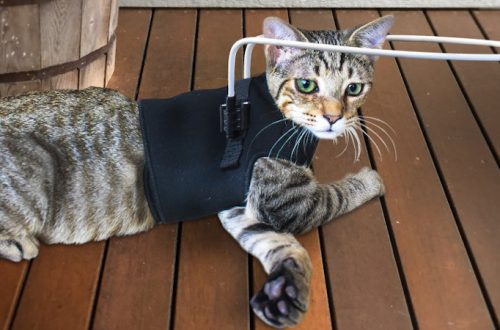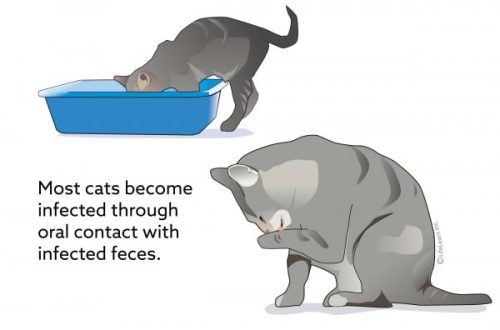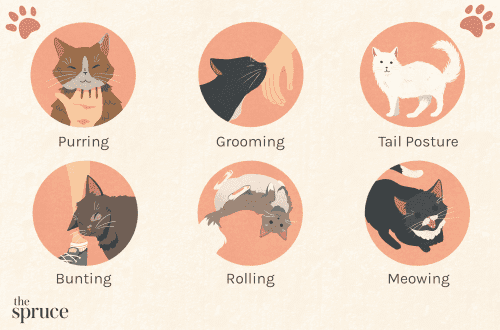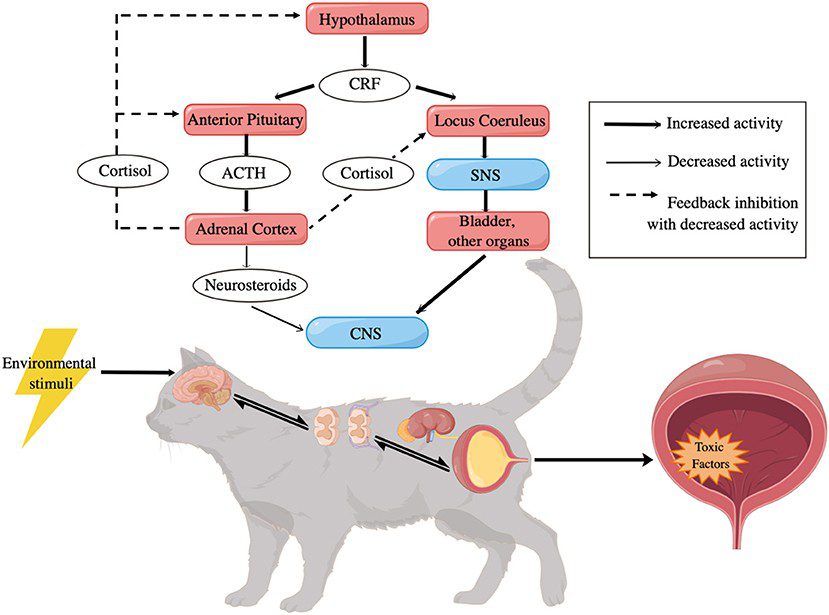
Cystitis na nwamba: ihe mere o ji eme, otú o si egosipụta onwe ya na otu esi emeso ya
ọdịnaya
Causes of cystitis in cats
Why do cats develop cystitis? The main reasons are considered to be the following:
- the penetration of bacteria into the cavity of the bladder (may be the result of an existing infectious pathology, weakened immunity);
- lack of fluid in the body;
- ọrịa shuga;
- helminthiasis;
- trauma to the urinary tract, internal organs (for example, due to a fall);
- adịghị ike nke sistem;
- hypothermia;
- bladder stones.
Cystitis in cats develops even due to stress. This may be a move, separation from the owner, the appearance of a new tenant (adult, child, animal) in the house, and so on.
Are there risk groups?
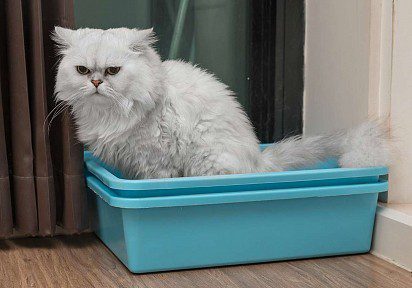
cat cystitis
Any mustachioed pet can get sick with cystitis, but cats and cats that are at risk can be distinguished. First of all, weakened animals are susceptible to cystitis: those who have had the disease, newborns, the elderly. Since their immune system is reduced, any infection or cold living conditions can provoke an inflammatory process.
Also, experts note that cats are more prone to cystitis than cats. And if we compare sterilized (castrated) animals with those who did not undergo surgery, then the former get sick more often. This may be due to both a weakened immune system and an infection introduced during the operation.
Types of cystitis in cats
There are the following types of cystitis in cats:
- hemorrhagic – proceeds in an acute form, blood is present in the secretions of the pet;
- serous-catarrhal – characterized by the presence of turbidity and mucus in the secretions;
- purulent – characterized by the presence of pus in the urine;
- idiopathic – is difficult to study, since it does not depend on any factors, it occurs in rare cases.
Depending on the nature of the course of the disease, acute and chronic cystitis are distinguished. The first in most cases flows into the second, even with a complete cure. The chronic form requires special attention to the pet, since the slightest oversight, such as a slight change in diet or a draft in the summer, can provoke an exacerbation.
Mgbaàmà nke cystitis
The main symptom of cystitis in cats is pain. Due to strong pain in a mustachioed pet, behavior changes:
- the cat can go to the toilet anywhere in the house, even if she is accustomed to the tray;
- due to pain during urination, the animal makes corresponding plaintive sounds;
- after the cat goes to the toilet, her gait changes – she bends her back a little and seems to “drag” her legs;
- the pet has an increased urge to urinate;
- the cat may not move for a long time;
- the animal often licks the crotch.
Because of the soreness of the abdomen, the cat does not allow to touch it, breaks out and meows. Other symptoms are gradually added: body temperature rises, bloody or purulent discharges appear from the genitals, the animal refuses to eat, in some cases it has a gag reflex.
Nchọpụta nke cystitis
Before treating cystitis in cats, it is necessary to conduct a diagnostic examination. Urine for analysis can be collected at home, and then brought to the clinic with your pet. To make a diagnosis, your veterinarian may order an ultrasound or x-ray. With the help of cystoscopy, a specialist will examine the mucous membrane of the bladder and urinary tract. Scraping from the urethra and subsequent bacteriological analysis will help determine the pathogen. In each case, it is necessary to pass general urine and blood tests.
How to treat cystitis in a cat
Treatment of cystitis in cats is complex and includes taking drugs from different groups.
Nkwadebe
Usoro onunu ogwu (kwa ụbọchị)
Agụmakwụkwọ (ụbọchị)
ntụziaka
Ndị na-ahụ maka nje bacteria
Levomycetin (tab)
10 mg / n'arọ
5-7
With food, three times a day
Gentamicin (injections)
2,5 mg / n'arọ
7
Twice a day, in the absence of kidney disease
Kanamycin
0,1 ml / n'arọ
7
Ugboro abụọ n'ụbọchị
Antispasmodics, painkillers
Papaverine
0,3 ml
Dị ka nke
In the form of subcutaneous injections
Drotaverine
0,5-1 ml
Dị ka nke
Intramuscular injections. No more than twice a day
Analgine
0,1 ml / n'arọ
Dị ka nke
Injections into the muscle. Do not inject for a long time
Ndị na-ahụ maka ọgwụ nje
Urotropin
2-4 ml
Dị ka nke
Used for acidic urine pH
Salal
0,04 g / n'arọ
Dị ka nke
Apply at alkaline pH
Furadonin
5-10 mg / kg
Dị ka egosi
The dosage is divided into 3-4 doses. Do not give to cats with kidney failure
Immunomodulatory drugs
Anandin
5-20 mg / kg
Dị ka nke
Muscle injections. The minimum dosage is used to prevent exacerbations
Immunofan
1 ml
30
In the form of intramuscular injections. Once a week followed by a repeat after 7 days for 4 weeks
Fosprinil
0,2 ml / n'arọ
5
Muscle or subcutaneous injections
Rehydrating (intravenously)
Trisol
7% site na ibu
Dị ka nke
-
Firastvor + vit. C + glucose
20-60 mg / kg
Dị ka nke
-
Nkwadebe ahịhịa
Cantaren
4 ml/day
5-28
Injections are made twice a day at equal intervals. The minimum course – for the acute form of the disease, the maximum – for the treatment of chronic cystitis
Kotervin
3 ml
7
Reception inside. A single dose is taken as a preventive measure, twice a day for treatment.
In addition to injections and drugs for internal use, the treatment of cystitis requires washing the bladder with special solutions. Most often, furatsilin, boric acid, saline, kotervin are used for this purpose. Lavage is carried out only in the clinic by catheterization. The dosage, frequency of procedures, duration of the course is determined by the veterinarian, based on the condition of the animal.
Application of Stop Cystitis
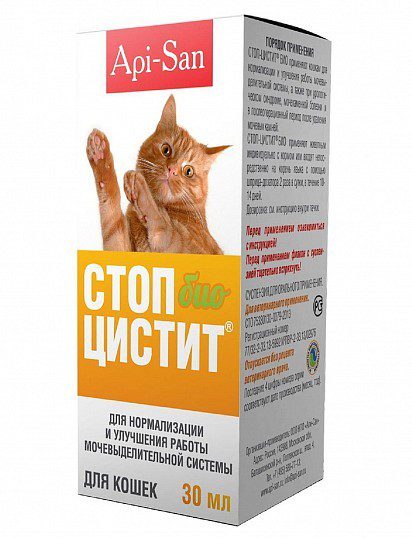
Stop cystitis for cats
Among other herbal preparations intended for the treatment of cystitis in cats, the most popular among owners and veterinarians is Stop-cystitis and its modification Stop-cystitis Bio.
The medicine is not in vain considered the best: it effectively eliminates the inflammatory process, has a diuretic and antimicrobial effect, relieves spasms and eliminates pain in many pathologies of the feline urinary system, as well as cystitis. The first option is presented in tablet form and in the form of a suspension, the second – only suspensions. The average cost of drugs is 200 rubles, while Bio is 20-30 rubles more expensive.
- Stop cystitis. Contains components of plant origin, used as a remedy. It has a complex effect on the organs of the urinary system of the animal. Usually a single dosage of the drug is 2-3 ml of suspension or 1-2 tablets. In the treatment of the disease, it is taken twice a day, and for preventive purposes – one. The duration of the course is 5-7 days. Can be given to newborn kittens and cats awaiting replenishment.
- Stop cystitis Bio. More related to preventive and curative supplements, as an addition to basic medicines. Allows you to improve the functioning of the kidneys and bladder, facilitates their condition during the recovery period, prevents the formation of sand and stones, stops inflammation at the initial stage. Despite the fact that this is a biological supplement, it can only be used according to the indications of a veterinarian. The dose, frequency of administration and duration are the same as in the previous version, unless otherwise established by a specialist.
Although Stop cystitis is of natural origin, according to the instructions, it has contraindications for taking: diseases of the heart and blood vessels, kidney failure. Stop Cystitis Bio can be given to all cats without exception. Both drugs practically do not cause adverse reactions, but sometimes individual intolerance to animals of any ingredients is possible.
Ọ ga-ekwe omume iji ọgwụgwọ ndị mmadụ
In the treatment of cystitis in felines, it is permissible to use traditional medicine methods as additional ones and only with the permission of a veterinarian. Firstly, this is due to the fact that folk recipes alone will not completely cure the disease (at best, it will become chronic). Secondly, not all remedies suitable for treating people are suitable for cats. In addition, some herbal preparations can not only neutralize the effect of drugs, but also react with them, leading to serious side effects.
As a rule, diuretic and anti-inflammatory herbs and fees are used for cystitis. The most popular are linden, dandelion, calendula, birch, bearberry. The prepared infusion is given to the pet in small quantities (according to age) several times a day.
Sometimes it is advised to put warm compresses on the cat or put a heating pad on the bed. However, such measures can lead to the opposite result: to cause exacerbation or complications, deterioration of the animal’s condition.
Features of caring for a cat with cystitis
Treatment of cystitis in cats is usually carried out at home, which imposes certain obligations on the owner and requires increased vigilance. The main thing is that the pet is isolated from drafts (even in the warm season), and also does not experience stress.
The cat needs to provide a warm place to rest and sleep, in no case should it be damp or wet. You should not take any measures to warm the bedding, it is enough to lay a warm blanket.
Particular attention should be paid to the nutrition of the fluffy patient. If the animal is accustomed to eating industrial food, then you need to choose the most suitable one. Which one – the doctor will tell you, since the therapeutic compositions differ from each other, and at different stages of the disease it will be necessary to buy a certain composition. Cheap mixtures should be immediately excluded. When cystitis is recommended to purchase:
- Hill’s c/d Feline Urinary Stress;
- Royal Canin Urinary S/O Feline High Delution;
- Royal Canine Urinary S/O Feline Pouches.
When feeding a cat naturally, it will need to be “put” on a special therapeutic diet with a reduced amount of protein products and salt. With cystitis, any fish and all dishes based on it are completely excluded from the pet’s diet.
It is allowed to feed the animal with boiled meat products, sour cream, cottage cheese, kefir no more than twice a week. The main menu should be cereals (millet, buckwheat, oatmeal), vegetables, broths.
Mgbochi
Some preventive measures will reduce the likelihood of cystitis in a cat to a minimum. Among them, special attention should be paid to the following recommendations:
- the animal must eat fully and correctly, in accordance with age and physiological characteristics;
- the cat must always have a bowl of clean water;
- the pet should not be allowed to eat only dry food, the diet should be diversified;
- the resting place of a mustachioed pet should not be located in a draft, near an air conditioner or fan;
- do not feed the cat “from the table”, completely exclude smoked, fatty, fried and spicy foods, as well as sweet foods;
- exclude stressful situations – do not punish physically and do not put pressure on the psyche;
- if in the life of a cat there have already been cases of inflammation of the bladder or other diseases of the urinary system, it is important to carefully monitor its condition, preventing the development of exacerbations and always having medicines on hand.
Recovery can only be achieved if the instructions of a specialist are followed. It should be remembered that cystitis in cats can return at any time, so the owner is required to love and take care of his pet, providing him with timely assistance.



